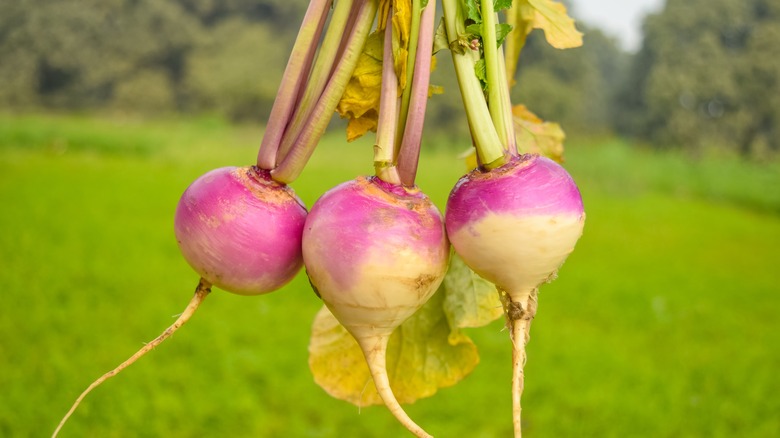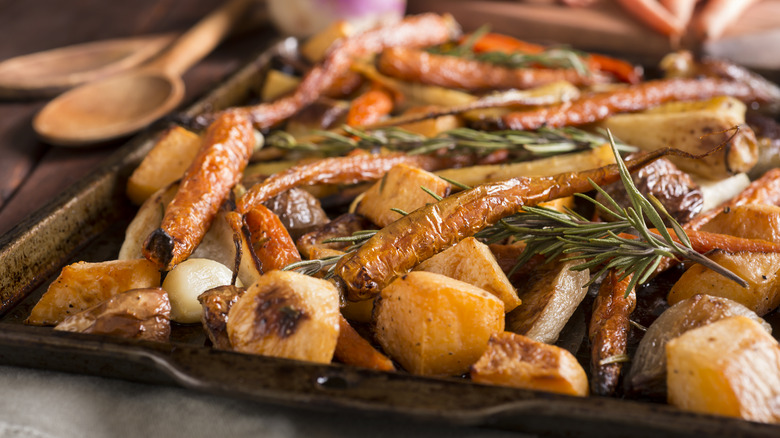Turnips Vs Parsnips: The Difference Between These Two Root Vegetables
Root vegetables have tons of culinary applications. You can make roasted root vegetables, of course, but smooth root vegetable purees are also all the rage. But while you're likely familiar with potatoes and carrots, there are other root vegetables out there. Take parsnips and turnips, for example. These are pretty similarly named, so they must be pretty close to each other, right?
Nope! You can certainly be forgiven for confusing turnips and parsnips; after all, not only are they both root vegetables, but both also end in the same syllable. However, they're actually very little alike in flavor, nutritional profile, and especially appearance — you'll never confuse one for the other if both are in front of you. They don't even belong to the same biological family: Parsnips are in the "Apiaceae" family, which includes carrots, celery, and parsley, while turnips are actually a "Brassicaceae," meaning they share a family with things like broccoli, cabbage, and Brussels sprouts.
Turnips and parsnips look and taste very different
The difference in appearance between the two is the first thing you notice. Turnips are small and rounded, with a color gradient that goes from a pinkish-purple at the top to white at the bottom. Parsnips, meanwhile, pretty much look like white carrots (the Romans even originally classified them as carrots), and in terms of texture, carrots and parsnips are quite similar. By contrast, turnips are more similar in shape and color gradient to rutabagas, although rutabagas are larger and grade more from a brownish-purple to yellow. Parsnips and turnips both have green leafy stems, but parsnip leaves tend to be thinner, while turnip greens (another name for the leaves) are more thick.
They also taste very different. Turnips tend to taste more bitter and spicy, especially the larger ones, while smaller turnips are a bit more mild. The flavor of parsnips, on the other hand, has been compared to a more candy-like version of a carrot. In fact, before sugarcane became prevalent, parsnips were sometimes used as a sweetener, albeit one with some complex peppery qualities.
Cooking preparations are often different, but overlap
Parsnips and turnips are used in cooking in ways that are sometimes similar and sometimes different. Parsnips are more likely than not to be cooked (although you can eat them raw), while turnips are often eaten raw as a garnish on salads or as a component in coleslaw. Mashed cooked turnips, meanwhile, are sometimes used as a replacement for mashed potatoes, since they result in a similar texture. Both frequently feature in purees, though, and both are also frequently roasted in dishes like garlic and thyme leg of lamb with parsnips. Sometimes, they're even roasted and served together. Turnip greens are also a classic Southern dish, typically prepared through braising. Parsnip greens are likewise edible, but they don't have the historical culinary prevalence of turnip greens.
Nutritionally, both are low in carbohydrates, but beyond that, there are some key differences. Turnips feature more fiber, vitamin C, and vitamin A (parsnips actually don't have any vitamin A) and less sugar (unsurprising, considering parsnips' sweetness). In comparison, parsnips have more protein, calcium, iron, magnesium, potassium, and vitamins E, K, and B1 through B5. Turnip greens actually do contain many of these nutrients, so don't sleep on them.


